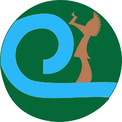|
Our Stewardship Week interviews continue with Sarah Jones’ interview with Brad Guhr from Dyck Arboretum about pollinators and native plants.
SJ: Please describe your job at Dyck Arboretum. BG: I am the education/prairie restoration/concert series coordinator at Dyck Arboretum of the Plains. The focus of my work and description of my job varies quite a bit from season to season. It includes coordinating and teaching the Kansas Earth Partnership for Schools K-12 teacher training program along with other elements of native plant gardening/restoration for all ages, planting and management of our Prairie Window Project prairie reconstruction, coordination of our Prairie Window Concert Series, and grant writing. SJ: What drew you to the Arboretum – what are you passionate about? BG: I am passionate about the conservation and restoration of native plant communities and their ecosystems. In Kansas, that mostly refers to the prairie. I channel that passion into helping people of all ages learn about and experience the prairie through either large-scale prairie restoration or small-scale prairie gardening. The Dyck Arboretum of the Plains with a mission "to cultivate transformative relationships between people and the land" is a great place to carry out this passion I have for prairie restoration and education. SJ: Why are pollinators, in general, important? BG: Pollinators are important in helping plants complete their life cycle. They also are important elements of a thriving ecosystem. SJ: What are the most common pollinators we have in this area? BG: As a plant person with an education based in botany and ecology, my knowledge of insect pollinators is based only on what I learned from one entomology class in graduate school many years ago and what I've learned through observation in the last couple of decades. Based solely on qualitative observations, I'd say the most common pollinators I see in Kansas would be native bees and flies. That said, I also see many beetles, butterflies and wasps on flowers as well. SJ: What are native growing plants people should make sure to leave (ones beneficial to local pollinators)? BG: All native plants play an important role in providing beneficial nectar and pollen for pollinators, so it is difficult to pick any one plant or group of plants being more important than another. To better answer this question, it would be helpful to narrow the focus to season and the group of pollinators being considered. For example, in fall, asters and goldenrods are among the more important groups of nectar plants through the prairie states for migrating monarch butterflies. SJ: Are there benefits of native plants vs non-native plants in terms of pollinators? BG: Native plants have evolved over thousands of years with a reliance on being pollinated by certain pollinators that have evolved along with them. These plants and pollinators have developed specific sizes, shapes, and a coexistent time scales of activity that usually helps them meet the needs of each other. When a non-native plant is introduced to a new area, it is not always assured that a pollinator will be present and have the right characteristics to benefit from the flowers of that non-native species. SJ: What are some easy window box type plants that aid pollinators? (So people can still help pollinators even when stuck inside under lockdown.) BG: Species of plants from the genera of Coreopsis, Gaillardia, Agastache, Salvia, and Asters (short in stature) are all easy and quick bloomers that come to mind as good examples for planting in window boxes. SJ: What are the best plants to have in your yard to help pollinators? BG: The best plants to establish in your yard for pollinators are the native species that will fit the conditions of that yard best. So, prairie species for sunny areas, woodland understory species for shady areas or on the north side of structures, wetland plants for lower areas that stay wet, etc. When using species native to an area that fit the conditions of the location, the plants will thrive, flower, set seed, and provide food as host plant and pollination source (for pollinators) alike. SJ: Are there classes or resources that Dyck Arboretum offers for people interested in gardening with native plants and gardening to attract pollinators? BG: Dyck Arboretum of the Plains regularly hosts native plant gardening/landscaping classes every late winter and late summer to help inspire and educate the public before the two most popular planting times of spring and fall. We also sell native plants at our FloraKS Native Plant Sales in spring and fall. One can learn more about our classes and native plant sales at www.dyckarboretum.org.
0 Comments
Leave a Reply. |
Proudly powered by Weebly

